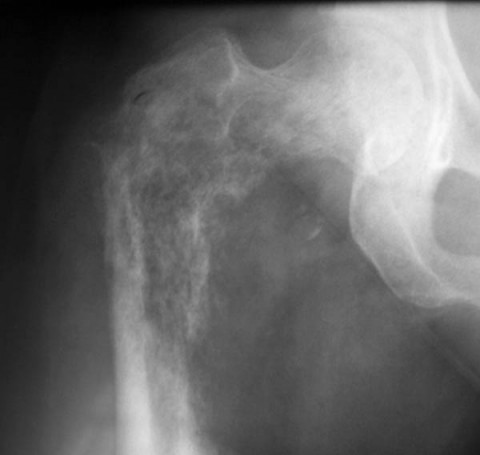Case Identification
Case ID Number
Tumor Type
Body region
Benign or Malignant
Clinical case information
Case presentation
A 43 year old woman with a history of breast cancer with bone metastasis presents with severe hip pain and inability to walk. Plain radiographs and a CT image of her right proximal femur are shown.
Radiological findings:
The patient has been active and her general condition is quite good. You have decided that the patient has the appropriate indications for operative intervention. What procedure do you choose?
Treatment Options:
The failure rate associated with fixation devices used to stabilize metastatic lesions of the proximal femur has been published . What is the liklihood of failure of a proximal femoral plate and compression screw device based on this report? What is the reported overall failure rate at 60 months for femoral fixation?
Special Features of this Case:
Here is a abstract of a publication that addresses this reconstructive challenge:
Clin Orthop 1990 Feb;(251):213-9
Metastatic bone disease. A study of the surgical treatment of 166 pathologic humeral and femoral fractures.
Yazawa Y, Frassica FJ, Chao EY, Pritchard DJ, Sim FH, Shives TC.
Department of Orthopedics, Mayo Clinic, Rochester, MN 55905.
A retrospective study of the surgical treatment of 166 metastatic lesions of the humerus and femur in 147 patients was performed. There were 106 women and 41 men whose average age was 62 years. Two-thirds of the patients were treated for complete fractures, while one-third were treated for impending fractures. Breast, lung, and kidney carcinoma accounted for the majority of the primary lesions. One-half of the patients died within nine months of surgery, while one-quarter were alive 19.1 months after surgery. The patients with breast cancer had the best prognosis, while the patients with lung cancer had the worst. The probability of implant failure increased linearly with time to 33% at 60 months. The probability of failure for the femoral lesions was greater, with 44% at 60 months. The average survival in the patients with failed fixation in the femoral lesions was 34.5 months with a mean interval to failure at 17.7 months. The failure rate was high (23%) in proximal femoral lesions treated with a compression screw or nail plate. Common reasons for failure included poor initial fixation, improper implant selection, and progression of disease within the operative field. Bone cement augmentation should be used with the fixation device when possible. Complications due to hip-screw cut-out from the head may also be reduced by applying bone cement around the screw threads.
Clin Orthop 1990 Feb;(251):213-9
Metastatic bone disease. A study of the surgical treatment of 166 pathologic humeral and femoral fractures.
Yazawa Y, Frassica FJ, Chao EY, Pritchard DJ, Sim FH, Shives TC.
Department of Orthopedics, Mayo Clinic, Rochester, MN 55905.
A retrospective study of the surgical treatment of 166 metastatic lesions of the humerus and femur in 147 patients was performed. There were 106 women and 41 men whose average age was 62 years. Two-thirds of the patients were treated for complete fractures, while one-third were treated for impending fractures. Breast, lung, and kidney carcinoma accounted for the majority of the primary lesions. One-half of the patients died within nine months of surgery, while one-quarter were alive 19.1 months after surgery. The patients with breast cancer had the best prognosis, while the patients with lung cancer had the worst. The probability of implant failure increased linearly with time to 33% at 60 months. The probability of failure for the femoral lesions was greater, with 44% at 60 months. The average survival in the patients with failed fixation in the femoral lesions was 34.5 months with a mean interval to failure at 17.7 months. The failure rate was high (23%) in proximal femoral lesions treated with a compression screw or nail plate. Common reasons for failure included poor initial fixation, improper implant selection, and progression of disease within the operative field. Bone cement augmentation should be used with the fixation device when possible. Complications due to hip-screw cut-out from the head may also be reduced by applying bone cement around the screw threads.
Image

Secret Tumor Name
Case ID Number
Image Types
Image modality
Tumor Name
Example Image
yes
Tumor Type
Benign or Malignant
Body region
Bone name
Location in the bone
periosteal reaction
position within the bone
Tumor behavior
Tumor density









